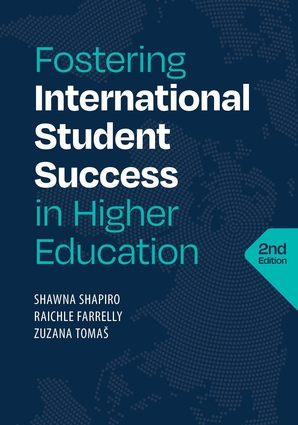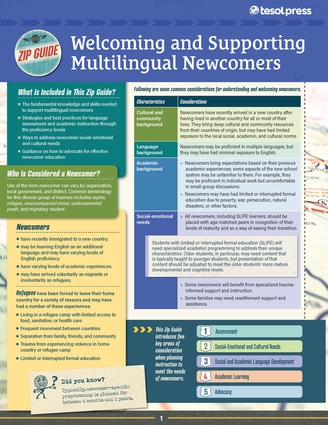Ask a TESOL Leader: "How can I develop a good network of like-minded educators?"
by Kate Mastruserio Reynolds
Question: "How can I develop a good network of like-minded educators? In my school, I’m the only English language teacher."
Being the only educator of multilingual learners at
your school can feel isolating. I experienced that feeling for years in my
work. It was challenging because other teachers did not seem to understand the
multilingual learners of English (MLEs), their process of language acquisition
and learning, my instructional role, or effective practices for supporting the
social and academic language learning while learning grade-level academic
content knowledge. Over the years of working in different contexts, I have come
to discover that I had been sitting back and waiting for the other teachers to
invite me and my students into their setting. Instead, I now understand that I
need to invite them into my setting.
I’m happy to share some strategies to help you develop your own community of
practice (for more on communities of practice, see “Situating
Learning in Communities of Practice” and
Situated Learning: Legitimate
Peripheral Participation).
Outreach is the first strategy
I would like to promote. Many of our colleagues might be interested in our work
with MLEs, but we need to reach out to them to invite them in. We want to start
with those who are approachable and may have expressed some support and
interest. Here are some ideas to do that:
-
Host a coffee/tea chat in the teachers’
lounge.
-
Have an open house of your classroom and invite
colleagues and parents.
-
Post information in shared spaces about MLEs’
rights or instructional strategies for MLEs and encourage colleagues to talk to
you about the topic.
-
Create a WhatsApp group for educators at your
school to connect on topics related to MLEs.
-
Write invitation cards to invite colleagues to
get to know you and what educators of MLEs do.
Regardless of the strategy, remember you are
building your own community of practice, and it may take multiple attempts to
encourage people to connect.
Bridges of understanding is
the second strategy that is a natural outcome of outreach. When we create
opportunities for interested colleagues to experience our work in our classroom
or other instructional setting, and we all share our ideas about practices and
resources, we construct bridges of understanding. We can approach our general
education peers from an inquiry stance to learn about their work as a starting
point. If we ask them what they love about their content area, or what unit
they find the most engaging, we open doors for more conversation. It takes
listening, sharing, and time to allow other educators and the teacher of MLEs
to bridge the differences in knowledge sets, perspectives, instructional and
assessment practices, and priorities (e.g., content knowledge, language
acquisition, content coverage, engagement, meaningful learning). As
conversations develop, we can share stories of our learners and their
experiences and what we do and why.
Sustained connection is the
third strategy to build your community of practice (read more about this topic
in “From
Teacher Isolation to Teacher Collaboration: Theoretical Perspectives and
Empirical Findings”). When we identify a modality for regular
connections, you and your peers can share successes, challenges, questions, and
solutions. You can share resources among one another. Recently, I was invited
into a community of practice with Egyptian English language teaching
supervisors of teachers on WhatsApp. This community did not know each other at
first, but with different leaders sharing tips, tools, and ideas, the community
members began to do the same. We need to be sure to ask questions and be good
listeners to our colleagues’ experiences. In my experience, we will find
individuals who are willing to engage in modifying their instructional
practices, coteach with us, or stand with us on an advocacy issue.
Up to this point, I have been sharing strategies
for you to connect with your peers at your school. However, you already have a
community of practice through TESOL International Association. When I was the
most alone in my school, I always had my TESOL community to connect with. I did
this by joining an Interest
Section/Professional Learning Network on the myTESOL forum. You can chat
virtually with other educators who have the same interests you do (e.g., K–12,
social justice, second language writing, or speaking/listening/pronunciation).
Or you can attend a regional
TESOL affiliate conference or the TESOL
International Association Annual Convention. I hope to see you online
or at a conference. Be sure to say hello!
Do you have a question for the TESOL leadership? Email your question to tc@tesol.org with the subject line "Ask a TESOL Leader" and it could be featured in this column!
Dr. Kate Mastruserio Reynolds
is a professor of TESOL/literacy at Central Washington
University. A licensed K–12 educator, she has taught preservice and in-service
teachers and ELT in K–18 public school settings globally. Dr. Reynolds’
publications include Introduction
to TESOL: Becoming a Language Teaching Professional. She
has forthcoming books on LGBTQ+ allyship in ELT, decolonizing advocacy, and
K–12 teacher research narratives. In 2022, she was inducted onto the TESOL
International Association’s Board of Directors (2022–2025).
TESOL Blogs
Interested in writing a blog for TESOL?
Read the submission guidelines and send us your post!
Check out some of the most recent TESOL Blogs:
|
10 Tips for Hosting Successful PD Workshops, by Sarah Hodge

Professional development days are the perfect time to reconnect, learn, and share. Here are 10 tips for hosting successful workshops, even if you’re a first-time presenter. |
TESOL Bookstore

Featured Resources from TESOL Press
ELT Basics is an invaluable resource for those seeking a straightforward, practical, and foundational understanding of English language teaching. This book covers a broad range of important topics, such as what it means to “know” a language, how people learn new languages, and what teachers can do to teach English effectively. Whether you’re looking for a basic understanding of ELT or considering a career in language teaching but want to know more first, this book will teach you about language acquisition as well as how to plan, instruct, and assess multilingual learners of English.
 Fostering International Student Success in Higher Education, Second Edition
Fostering International Student Success in Higher Education, Second Edition
Shawna Shapiro, Raichle Farrelly, Zuzana Tomaš
(Copublished by TESOL and NAFSA)
The increase in the number of international students attending English-dominant schools brings benefits as well as challenges for institutions. Shapiro, Farrelly, and Tomaš provide a lively, informative discussion that answers the questions instructors commonly ask when seeking to ensure success for these students: What do I do to help students be successful in U.S. academic culture? How can I ensure that the content for my course is comprehensible to students who are still learning English? How do I design assignments and assessments that are fair while still acknowledging the difficulty of doing academic work in a second or foreign language? How might I treat international students as a linguistic and cultural asset in the classroom, and help them to become institutionally integrated?
 TESOL Zip Guide:
TESOL Zip Guide:
Welcoming and Supporting Multilingual Newcomers
Amber Warren, Melissa Hauke, Jan By Ying Hui-Michael, Adrienne Johnson
Newcomers are students who have recently immigrated to a new country, may be learning English as an additional language, and may have varying levels of English proficiency. This guide introduces five key areas of consideration when planning instruction to meet the unique social-emotional, linguistic, cultural, academic, and programming needs of multilingual learners of English who are newcomers. It includes strategies and best practices for language assessment and academic instruction through the proficiency levels, and guidance on how to advocate for effective newcomer education.